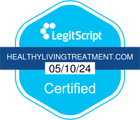Frequently Asked Questions
Click on the links below to find more information on how to get the help you, or a loved one, needs.
Click on the links below to find more information on how to get the help you, or a loved one, needs.
With the approval of our staff, you are allowed to bring a small dog with you to help in your recovery process.
Substance abuse and addiction have high costs, often adversely affecting work performance, personal relationships, and your physical health. To determine if you are addicted, the National Council on Alcohol and Drug Dependence has two quizzes to help you find out: Am I Alcoholic? and Am I Drug Addicted?
Different programs and levels of addiction require different program lengths. If you are very addicted to a drug, you will likely take longer to fully rehabilitate than someone with a mild addiction. Also, the type of treatment program you choose will offer different duration options.
The common rehab lengths are:
Rehab treatment often employs similar therapies when treating different drug addictions because the path to recovering from any drug requires training the brain to respond differently to triggers and drug cravings.
While the majority of programs treat multiple drugs, some centers treat alcohol abuse alone. Many other centers may have specialized programs for certain drugs, but they do not only treat people with that one drug addiction.
Addiction is impossible to fully “cure” because it is as much about overcoming a chemical dependency as it is behavioral training. For instance, each time the brain accesses the drug, the brain experiences chemical changes outside the norm and essentially rewires because of those intense surges of drug-induced activity. Likewise, the person is then trained by the brain to want more of the drug, so they act on cravings consistently.
Scientific studies and clinical trials have created some drugs to help the brain recover from chemical changes, but much of rehab focuses on behavioral changes. To achieve long-term abstinence, therapists first help users rethink why they are craving the drugs, and then they help them learn how to overcome those cravings. They will also help them address other psychological difficulties that may have contributed to the substance abuse.
While rehab cannot keep people from ever using drugs again, it does give individuals tools to use when facing drug cravings, and it gives encouragement to continue staying healthy and clean.
According to the National Institute on Drug Abuse, detox is the process of “allowing the body to rid itself of a drug while managing the symptoms of withdrawal.” There are two basic approaches to detox: Medications can be prescribed that can gradually wean the body of the substance, or the natural approach can be used (quitting “cold-turkey”).
Detox can be completed on its own in a stand-alone facility or as part of the rehabilitation process at a rehab center. The rehabilitation process is made up of assessment, detox, therapy, and aftercare.
Rehab is the initial part of recovery and has four stages, including assessment, detox, counseling, and aftercare. Recovery is the entire experience of getting off a drug and staying sober, encompassing the ongoing struggle to maintain abstinence and not relapse. Recovery includes the following steps, which start with the rehab process:
There is no limit to how often you can enter rehab because the goal of rehab is providing people with the resources and help they need to get sober. Sometimes, it takes more than one rehab program or one approach.
However, being successful in rehab the first time will save you time and money. The National Institute on Drug Abuse estimates that anywhere from 40-60% of people who enter rehab will relapse, but those numbers rise for those who don’t continue with aftercare after their stint in a rehab program. Programs like Alcoholics Anonymous, Narcotics Anonymous, and Sober Living Homes can all provide additional supports to help you stay clean after rehab and be successful.
Some intensive rehab programs, especially hospitalization, only accept people with severe addictions, but it is still important for anyone who may be addicted on any level to find help. Recent research shows that the best initial approach to light drug addiction, and sometimes even moderate addiction, may be searching out a therapist or counselor with a background in Substance Use Disorder or SUD. One good place to look is outpatient centers for drug addiction or SUD. You can find a comprehensive list of them in our directory.
It’s common to minimize an addiction or underestimate its power, which is a good reason to see a certified addiction therapist or go through a screening process for outpatient care. Even if you think you are barely addicted, a specialist would be able to explain exactly where you currently are on the addiction spectrum and give you evidence-based suggestions for how to move forward, either with counseling or in a more structured rehab program.
Going to rehab close to home may be best for people who:
Going to rehab away from home may be best for people who:
A trained addiction counselor or medical professional can use an ASAM assessment to determine your level of addiction and make a recommendation based on your specific situation. The main factors to consider involve:
Many rehab centers are equipped to help people from various demographics. Call and talk to the staff about your needs to gauge how you will feel in their treatment program.
If you are particularly interested in finding a rehab program geared toward a specific group, there may be programs available to you, but they may not be in a desirable location or could be more expensive than other treatment options. Some specialty rehabs are only available as residential treatment centers, which would be more expensive than a local outpatient rehab that is for everyone.
For example, there are rehab centers that provide programs specifically for the following groups:
Pricing depends on the program, services, and amenities offered. Typically, outpatient programs are cheaper than inpatient, and live-in inpatient facilities are the most expensive, costing anywhere from $6,000 to $30,000 or more per month (for the luxury centers).
In the middle are outpatient treatment centers that can provide multiple hours of services per day. They usually cost somewhere between $3,000-$10,000 for a three-month program. However, with insurance, some types of rehab and individual therapy with a counselor can be very affordable, only requiring a co-pay. Another affordable option is group therapy through non-profits or secular organizations like AA or NA, which is free.
Free rehab options include Alcoholics Anonymous, Narcotics Anonymous, and other types of peer-support groups. Other more affordable options include individual counseling with a certified therapist who has substance use disorder (SUD) experience. You can find out if therapy is covered by your insurance by calling them or looking at your insurance plan.
Some insurance providers will cover other parts of rehab like detoxification, but the majority will not pay for room and board at inpatient treatment centers, which accounts for much of the price at those programs.
Some rehabs offer payment assistance such as sliding-scale fees and scholarships.
The Affordable Care Act requires insurance to cover certain measures like screening for substance use disorder or addiction, detoxification, and therapy; however, you need to make sure the rehab or counselor you go to is in your network. Likewise, some insurers may require that you receive a screening before getting other services. Call them to verify what information they need before starting a program.
While insurance should cover at least some of your rehab treatment, many insurers do not pay for inpatient treatment centers because much of their cost is for room and board, which insurance is not required to cover.
Medicaid and Medicare fall under the Affordable Care Act, which requires insurance to cover certain measures like screening for substance use disorder or addiction, detoxification, and therapy. However, you need to make sure the rehab or counselor you go to is in your network, which you can find out by contacting your insurance provider. Likewise, some insurers may require that you receive a screening before getting other services. Call your insurer to verify what information they need before you start a program.
While insurance should cover at least some of your rehab treatment, many insurers do not cover inpatient treatment centers because much of their cost is for room and board, which insurance is not required to cover. If you want to go to an inpatient rehab, some centers offer payment plans and scholarships, which you can ask them about by calling or emailing.
There are two possible options for those needing to go to rehab: the Family and Medical Leave Act (FMLA) and Employee Assistance Programs.
According to the Substance Abuse and Mental Health Services Administration (SAMHSA), if you tell your boss that you plan to enter drug rehab, or give them other confidential information about your condition, they must maintain confidentiality and cannot fire you for sharing that information according to FMLA. If they do fire you and violate that confidentiality, there may be legal recourse; however, not every employee and every employer is covered by FMLA. See the FMLA guidelines and eligibility requirements here.
An important exception is if you are under the influence of drugs while working or have drugs in your system after a mandatory drug test that would be grounds for getting fired. Likewise, it is important to talk to your boss and clear time off for rehab beforehand, as leaving work unexpectedly could also get you fired.
Addiction treatment can be broken into four stages:
Individual therapy and group therapy both use similar therapy techniques like Cognitive Behavioral Therapy, but how they implement the goals of those therapies are different. In individual therapy, the strategies employed and the conversation itself is more one-sided, with the therapist guiding the conversation or the patient talking, whereas, in group therapy, everyone in the group is contributing and learning from each other, albeit in a facilitator-guided atmosphere.
Individual therapy may be best for people struggling with a specific trauma that they wouldn’t feel comfortable sharing with other individuals. Group therapy, on the other hand, is good for those who want to practice strategies with others, which is more similar to the real world and everyday life.
For the most part, rehab programs use a mixture of both individual and group therapy, but most free 12-step programs or alternatives solely use group therapy.
Group therapy for substance abuse usually happens in rehab programs and 12-step programs like AA or NA. Sessions consist of one or more therapists or facilitators and a group of 3-12 people, sometimes more for 12-step programs. Group therapy can focus on different skills, but typically it encourages those in the group to see that they are not alone, it gives them hope, it teaches them coping skills, and it provides an accepting and open atmosphere.
Group therapy also allows everyone to participate and talk in more engaging ways than the one-sided conversations typical of individual therapy. It also is usually more affordable and builds skills necessary for life after rehab such as talking with others, working through issues in group settings, or practicing coping strategies in real time.
Medication is used during the detox phase of rehab for many drugs, and in the therapy phase for certain drugs such as alcohol and heroin. Medication used in cases of opioid addiction is called Medication-Assisted Treatment (MAT).
Common medications include:
Additionally, there are drugs used to help with the side effects of withdrawal such as depression and anxiety.
Inpatient treatment requires patients to live in the facility (usually full-time), while outpatient centers are typically more flexible and do not include overnight services. Each treatment option offers a different approach and has a different ability to meet addicts’ needs.
One variance is with partial hospitalization. Unlike full hospitalization, partial hospitalization services are not overnight. However, partial hospitalization is still considered “inpatient” because of the extensive nature of their services and the nearly full-time commitment.
Inpatient treatment includes room and board, meaning they provide each of your meals as well as a room that you either have to yourself or share with others depending on the luxuriousness of the facility and program. Inpatient facilities also have in-house therapists, counselors, and other personnel to administer medications and monitor those living in the facility.
One important aspect of inpatient care is that it is the most expensive option because it provides room and board, sometimes costing up to $30,000 per month. Likewise, some question if it is significantly more effective than other treatment methods, encouraging individuals with a slight or early-stage substance use disorder to seek out other, more affordable options before going to an intensive program.
Outpatient care occurs in many different settings because it includes all rehab programs that do not provide overnight care. Outpatient programs include:
Holistic rehab programs operate under the assumption that a person’s entire self must heal to stop substance abuse permanently. To help individuals heal, many holistic programs will include various complementary treatments like acupuncture, massage therapy, reiki, and neurofeedback among others.
While many of these treatments are very popular right now, particularly in luxury rehabs, there currently is little scientific evidence to back these therapies and demonstrate they have a positive impact on those going through rehab.
Typically, living in a treatment center provides less privacy than living at home or in a sober living house, but the benefit is that each person is held accountable each day. Meals are provided, and the days are structured with group therapy, activities, watching informational videos, and individual counseling at some locations.
Treatment centers’ living accommodations vary based on the center and the price of the program. In some circumstances, patients will have a bedroom with their own bed, dresser, and small space that they share with multiple other people. The more expensive, luxury options offer private rooms and living areas. Likewise, the quality and food offered is based on the price of the center.
Rehab centers treat many drug addictions, sometimes working with people who are struggling to stop multiple addictions at the same time, which is why treatment centers do not allow alcohol, drugs, or drug paraphernalia at their facility. Cigarettes fall into the middle-ground, with some centers banning them for their trigger factor to other residents and others allowing them.
Many treatment centers encourage patients to bring the following items:
To create a safe-environment with the fewest triggers possible, many treatment centers do not allow the following items inside their facility:
Many treatment centers will not allow visitors initially because it is important for the patient to bond with their group members and therapists. Also, seeing loved-ones can cause undue stress to a patient who is just starting the process. After the initial period of treatment, many centers allow visitors during visiting hours and have designated spaces for the patient to visit with loved ones. After the patient has progressed, some treatment centers also allow patients to leave the center for short periods of time.
"*" indicates required fields





 <!—->
<!—->
